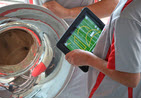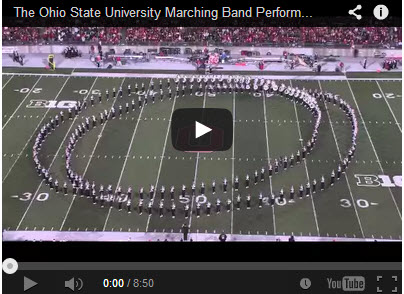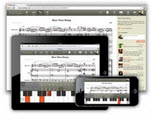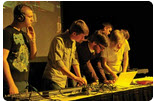Gateway to Musicianship with six ear training programs for classroom and at-home use
"Garbage in, garbage out” is a guiding mantra for building computers and apps. It’s also true for our students’ brains. We are in the business of empowering young minds with healthy, useful information. Thanks to significant new developments, music educators can effectively combine music theory and aural training to empower students with ownership of their music creating experiences.
Ear training can cover a broad spectrum of useful music tools. These include pitch recognition, intonation, rhythmic drills, harmonic understanding of how music fits together vertically, better understanding of triads, complex chords, intervals, scale recognition, and how chord progressions are linked together.
Read more:
Technology: Ear Training
The secrets to OSU’s paperless marching band rehearsals, increased efficiency, and much more

The OSU Marching Band has been a pioneer in utilizing technology in their drill preparation. Photo courtesy of The Fisher College of Business.
The marching band at The Ohio State University took the world by storm when their extraordinary marching routines of Michael Jackson’s moonwalk and T-Rex walking across the field were featured on national TV news spotlights. Their innovative introduction of iPads on the rehearsal field paid off. The band’s Oct. 26 performance of “Hollywood Blockbusters,” including Jurassic Park, has received more than 15 million views on YouTube:
Read more: Technology: Drill Prep Apps

The Best Music Apps for Educators
 These are exciting times for
music educators. Desktop computers and laptop notebooks
have slowly changed our modes of creating, teaching, and
assessing music. But tablets and smartphones have ramped
up the music experience faster and farther than we could
have imagined. The iPad and table computers are destined
to change the way we teach and interact with students and
technology. Today’s touchscreen sensitivity, which
eliminates the need for a mouse, has also changed the way
we work. This is important because it is gives us a more
tactile surface which directly influences how we
interface with data and music.
These are exciting times for
music educators. Desktop computers and laptop notebooks
have slowly changed our modes of creating, teaching, and
assessing music. But tablets and smartphones have ramped
up the music experience faster and farther than we could
have imagined. The iPad and table computers are destined
to change the way we teach and interact with students and
technology. Today’s touchscreen sensitivity, which
eliminates the need for a mouse, has also changed the way
we work. This is important because it is gives us a more
tactile surface which directly influences how we
interface with data and music.
Read more:
Technology: Music Ed Apps
From Scanning to Notation to Customized Creativity & Beyon
d
Ever wish that technology could change the way you prepare, teach, and assess your students? Or maybe help create customized instruction to better define how well all of your students are learning and progressing? Without a user-friendly assessment environment to enable this, teachers rarely have the time to be creative about exploring new solutions. But we are here to help!
Innovative new products now go beyond individual music software applications, incorporating power-user applications for targeted instruction. The key to creating music projects with the power-user concept is in converting files that can be used to transfer data across different software apps for enhanced instructional opportunities.
Read more:
Technology: Power-User Synthesis
Videoconferencing and Remote Music Instruction
Videoconferencing allows two (point-to-point) or more locations (multipoint) to communicate by simultaneous, interactive video and audio transmissions. An increasing number of schools across the country teach music technology classes via online classes locally and long-distance simultaneously.
Read more:
Technology: Videoconferencing
Center Stage: Tech-Oriented Band/String Methods for the Classroom
Exciting, innovative, and interactive technology is now integrated into the best band and string method books for students of all skill levels. The latest tech advances built into these methods are vastly superior to the CD recordings that were themselves innovative when they first became available in method books just 10 or 15 years ago.
 Now, it’s all about
customization. Students can record themselves and
instantly share those recordings with friends and
teachers. Practice is jazzed up with choices of loops,
styles, tempos, and modulations. Tuning has never been
easier thanks to on-screen chromatic tuner software apps.
Student assessment is easy and accurate. DVD video
recordings provide authentic instruction models and
explanations. And best of all, the price of instrumental
classroom method books is still a bargain even with new
and powerful technology features. Let’s take a closer look
at three methods that are leading this new charge: Sound
Innovations by Alfred Music Publishing, Essential Elements
Interactive by Hal Leonard Corporation, and Tradition of
Excellence by Neil Kjos Music Company.
Now, it’s all about
customization. Students can record themselves and
instantly share those recordings with friends and
teachers. Practice is jazzed up with choices of loops,
styles, tempos, and modulations. Tuning has never been
easier thanks to on-screen chromatic tuner software apps.
Student assessment is easy and accurate. DVD video
recordings provide authentic instruction models and
explanations. And best of all, the price of instrumental
classroom method books is still a bargain even with new
and powerful technology features. Let’s take a closer look
at three methods that are leading this new charge: Sound
Innovations by Alfred Music Publishing, Essential Elements
Interactive by Hal Leonard Corporation, and Tradition of
Excellence by Neil Kjos Music Company.
Read more:
Technology: Band Methods
Sequencing is the quickest and easiest way to involve students in their own music. Without years of training, sequencing introduces students to the elements of music: melody, rhythm, harmony, form, texture, and tone-color. It also ignites musical intuition through discovery of learning activities, in turn giving authentic first-hand experiences that strengthen performing skills. What was once only available to professional musicians is now in the hands of educators and students thanks to exciting new technology available with few budgetary restraints.
The Evolution of the Sequencer
Onboard sequencers built into MIDI keyboards are the oldest variety of sequencer, made popular 30 years ago before computers took over. Some keyboards today, with onboard sounds, allow students to record and store a performance (entirely with MIDI data), along with basic editing features like quantizing. Most of these even allow you to “layer” sounds, sometimes called “combinations,” or multi-timbral sounds. These types of keyboards are often referred to as arranger keyboards, and work quite well for those who regularly perform live on stage, without a computer, and need a “backing track” to perform with. Usually, the sequence produced can be stored as a MIDI file and later exported to a computer, usually via USB. In the old days, this was done by floppy disc drive. This style of sequencing has generally been overshadowed by newer techniques.
Read more:
21st-Century Sequencing Tools

SmartMusic
Sight-reading is a lost art form in many performance-dominated music programs. In the professional world, however, it is an essential part of musicianship. In a series of behind-the-scenes videos chronicling the making of the "Hobbit" it is explained that the entire movie score was never rehearsed, and was recorded in just one take without any previous rehearsals or individual practice. (See 11:02 in the link above for commentary from the famous Abbey Road Studios in London, where the 93-piece orchestra sight-read and recorded the sound-track 18,000 miles from the New Zealand movie set.)
Why this critical skill of sight-reading often gets neglected in the classroom is a complicated problem. For example, one band director responded to my inquiry about sight-reading in his rehearsal by complaining, "I'm tired of putting together and taking apart (daily) ensemble sight-reading folders. I'm thinking about not even working on sight-reading this year, except I have to because my school has been assigned to host the district Band and Orchestra festival, so I'd better have my students sight-reading well. Any help will be greatly appreciated."
Read more: Sight-Reading Software to the Rescue

Notation Heavy Hitters
Noteflight
First launched in 2007, Noteflight is the pioneer online notation tool. This powerful music writing application can be used to edit, display, and play back music notation through a standard web browser. It has an integrated online library of musical scores that anyone can publish, link to, or post online. Users can write music on a computer, tablet, or smartphone, and then share compositions with other users or embed them into a website.
Read more: Heavy Hitting Cloud Notation Tools
Epic economic dilemmas require epic solutions. Even while the struggling economy is negatively affecting education, positive and creative options are emerging in music education. We don't need to stand by while furloughs and cuts threaten our profession or watch fine performance ensembles be squeezed between single-section specialty classes. For years, School Band & Orchestra has thrown a spotlight on music educators who are thriving in spite of the downturns around us. And some of our finest innovators are using technology to come up with epic solutions.
One such innovator is Barbara Freedman, of Greenwich, Connecticut, TI:ME's 2012 Teacher of the Year. By reaching out to the wider student population with the help of technology, her music department is on stronger ground, music is being viewed as an educational necessity, and jobs and careers are no longer on the chopping block. As the music technologist at Greenwich High School for the past 11 years, Barbara successfully provides 300+ students (and a waiting list for more) with innovative composition and tech-performance experiences.

Bands, orchestras, and choirs have long been a staple of secondary education in this country. Our performing ensembles have proven to be a resilient and powerful way to actively engage students in music. However, there is a problem. Over the past 40 or more years our performing programs have engaged approximately 20 percent of high school students. While bands, orchestras, and choirs are great for this 20 percent, it leads to the question: "What about the 'other 80 percent'?"
The next question might be, "Why do I care?"
Generally speaking, music teachers are somewhat idealistic (not usually entering the profession for the monetary reward) and would agree with the statement that, "If music is important, it is important for everyone." As a profession, our mission is to enrich the lives of our citizens and the quality of our society through a deepened engagement with music. It is hard to achieve that mission when we don't see a majority of students past sixth grade in a music class or ensemble.

